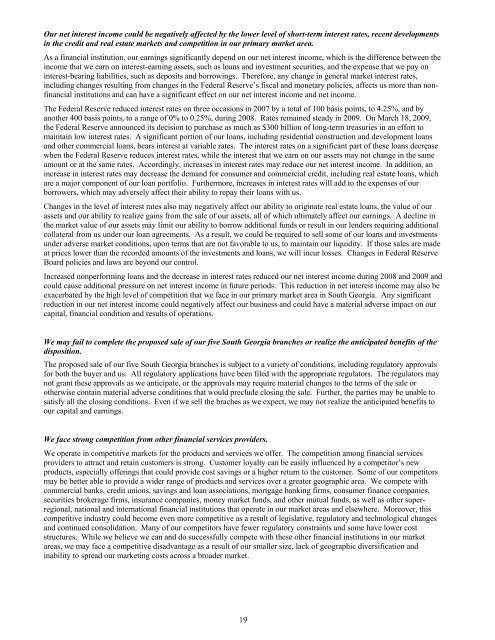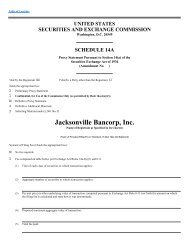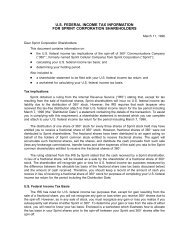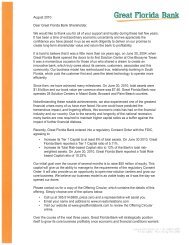pab bankshares, inc. - SNL Financial
pab bankshares, inc. - SNL Financial
pab bankshares, inc. - SNL Financial
Create successful ePaper yourself
Turn your PDF publications into a flip-book with our unique Google optimized e-Paper software.
Our net interest <strong>inc</strong>ome could be negatively affected by the lower level of short-term interest rates, recent developments<br />
in the credit and real estate markets and competition in our primary market area.<br />
As a financial institution, our earnings significantly depend on our net interest <strong>inc</strong>ome, which is the difference between the<br />
<strong>inc</strong>ome that we earn on interest-earning assets, such as loans and investment securities, and the expense that we pay on<br />
interest-bearing liabilities, such as deposits and borrowings. Therefore, any change in general market interest rates,<br />
<strong>inc</strong>luding changes resulting from changes in the Federal Reserve’s fiscal and monetary policies, affects us more than nonfinancial<br />
institutions and can have a significant effect on our net interest <strong>inc</strong>ome and net <strong>inc</strong>ome.<br />
The Federal Reserve reduced interest rates on three occasions in 2007 by a total of 100 basis points, to 4.25%, and by<br />
another 400 basis points, to a range of 0% to 0.25%, during 2008. Rates remained steady in 2009. On March 18, 2009,<br />
the Federal Reserve announced its decision to purchase as much as $300 billion of long-term treasuries in an effort to<br />
maintain low interest rates. A significant portion of our loans, <strong>inc</strong>luding residential construction and development loans<br />
and other commercial loans, bears interest at variable rates. The interest rates on a significant part of these loans decrease<br />
when the Federal Reserve reduces interest rates, while the interest that we earn on our assets may not change in the same<br />
amount or at the same rates. Accordingly, <strong>inc</strong>reases in interest rates may reduce our net interest <strong>inc</strong>ome. In addition, an<br />
<strong>inc</strong>rease in interest rates may decrease the demand for consumer and commercial credit, <strong>inc</strong>luding real estate loans, which<br />
are a major component of our loan portfolio. Furthermore, <strong>inc</strong>reases in interest rates will add to the expenses of our<br />
borrowers, which may adversely affect their ability to repay their loans with us.<br />
Changes in the level of interest rates also may negatively affect our ability to originate real estate loans, the value of our<br />
assets and our ability to realize gains from the sale of our assets, all of which ultimately affect our earnings. A decline in<br />
the market value of our assets may limit our ability to borrow additional funds or result in our lenders requiring additional<br />
collateral from us under our loan agreements. As a result, we could be required to sell some of our loans and investments<br />
under adverse market conditions, upon terms that are not favorable to us, to maintain our liquidity. If those sales are made<br />
at prices lower than the recorded amounts of the investments and loans, we will <strong>inc</strong>ur losses. Changes in Federal Reserve<br />
Board policies and laws are beyond our control.<br />
Increased nonperforming loans and the decrease in interest rates reduced our net interest <strong>inc</strong>ome during 2008 and 2009 and<br />
could cause additional pressure on net interest <strong>inc</strong>ome in future periods. This reduction in net interest <strong>inc</strong>ome may also be<br />
exacerbated by the high level of competition that we face in our primary market area in South Georgia. Any significant<br />
reduction in our net interest <strong>inc</strong>ome could negatively affect our business and could have a material adverse impact on our<br />
capital, financial condition and results of operations.<br />
We may fail to complete the proposed sale of our five South Georgia branches or realize the anticipated benefits of the<br />
disposition.<br />
The proposed sale of our five South Georgia branches is subject to a variety of conditions, <strong>inc</strong>luding regulatory approvals<br />
for both the buyer and us. All regulatory applications have been filed with the appropriate regulators. The regulators may<br />
not grant these approvals as we anticipate, or the approvals may require material changes to the terms of the sale or<br />
otherwise contain material adverse conditions that would preclude closing the sale. Further, the parties may be unable to<br />
satisfy all the closing conditions. Even if we sell the braches as we expect, we may not realize the anticipated benefits to<br />
our capital and earnings.<br />
We face strong competition from other financial services providers.<br />
We operate in competitive markets for the products and services we offer. The competition among financial services<br />
providers to attract and retain customers is strong. Customer loyalty can be easily influenced by a competitor’s new<br />
products, especially offerings that could provide cost savings or a higher return to the customer. Some of our competitors<br />
may be better able to provide a wider range of products and services over a greater geographic area. We compete with<br />
commercial banks, credit unions, savings and loan associations, mortgage banking firms, consumer finance companies,<br />
securities brokerage firms, insurance companies, money market funds, and other mutual funds, as well as other superregional,<br />
national and international financial institutions that operate in our market areas and elsewhere. Moreover, this<br />
competitive industry could become even more competitive as a result of legislative, regulatory and technological changes<br />
and continued consolidation. Many of our competitors have fewer regulatory constraints and some have lower cost<br />
structures. While we believe we can and do successfully compete with these other financial institutions in our market<br />
areas, we may face a competitive disadvantage as a result of our smaller size, lack of geographic diversification and<br />
inability to spread our marketing costs across a broader market.<br />
19
















